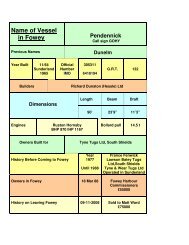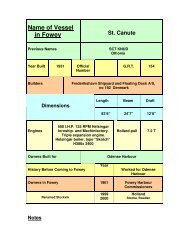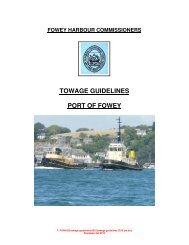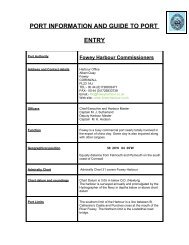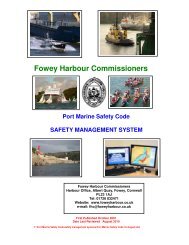Fowey Estuary Management Plan Fowey Estuary ... - Fowey Harbour
Fowey Estuary Management Plan Fowey Estuary ... - Fowey Harbour
Fowey Estuary Management Plan Fowey Estuary ... - Fowey Harbour
You also want an ePaper? Increase the reach of your titles
YUMPU automatically turns print PDFs into web optimized ePapers that Google loves.
<strong>Fowey</strong> <strong>Estuary</strong> <strong>Management</strong> <strong>Plan</strong> Section 11<br />
March 2003 Water Quality & Pollution<br />
Public awareness of water quality is important. The provision by the<br />
Environment Agency of more information about the estuaries water quality<br />
and water quality indicators would be beneficial to many users, particularly<br />
those participating in recreational activities. This information is becoming ever<br />
more available, particularly on the Environment Agency’s website. The public<br />
should be encouraged to report incidences of non-compliance or concern to<br />
the Environment Agency via their 24-hour pollution hotline number.<br />
11.2 Identify and reduce sources of diffuse or other pollution<br />
There is a considerable amount of farmland and forestry around the estuary<br />
and it is not surprising therefore, that land run-off enters the estuary. This is<br />
probably one of the biggest sources of diffuse pollution that enters the<br />
estuary. The Environment Agency works with a number of organisations to<br />
regulate and minimise pollution from diffuse sources (e.g. run-off from<br />
agricultural land) within the catchment. However, many sources of pollution<br />
entering the streams and rivers have unknown bacteriological, biochemical<br />
and nutrient loads. It is difficult to trace and record the occurrence and origins<br />
of diffuse pollution, especially with regards to responsibility.<br />
The <strong>Fowey</strong> Voluntary Marine & Coastal Conservation Area Committee are<br />
actively encouraging and supporting the take-up of agri-environment grant<br />
schemes such as Countryside Stewardship by liaising with landowners and<br />
other organisations to encourage sympathetic land management techniques<br />
that could reduce the risk of polluting substances entering the estuary.<br />
Heavy metals are also a source of diffuse pollution. Nationally significant<br />
sediment loads of copper and zinc have been recorded at Restormel, a legacy<br />
of old mine workings and abandoned mines. This occurs in many rivers in<br />
Cornwall as a result of intensive historic mining. Heavy metal quantities in the<br />
river water cannot be reduced, but monitoring keeps a check on the levels.<br />
11.3 Reduce pollution from boats<br />
Pollution from boats in the form of litter, fuel, oil and sewage should be<br />
prohibited. <strong>Fowey</strong> <strong>Harbour</strong> Commissioners provide facilities and services for<br />
visiting and resident craft within the <strong>Harbour</strong>. Other boatyards should also<br />
have facilities for the safe disposal of waste that arises from their operations.<br />
All boat types need to use anti-fouling paints, but consideration should be<br />
taken of their polluting effects on the environment. Legislation has banned use<br />
of TBT based antifouling on boats under 25m in length and no boatyard in<br />
<strong>Fowey</strong> can take vessels over this threshold. However, copper based<br />
antifouling is used, which is by definition toxic to marine life. Promotion of<br />
good practice for the disposal of anti-fouling paints and other substances from<br />
painting and scrapping of boats and marine structures should be encouraged<br />
by all businesses working on the estuary.<br />
Other sources of pollution from commercial and recreational craft may be of<br />
concern to the Environment Agency, DEFRA and the MCA.<br />
Page 34



